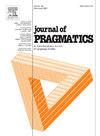“我不好意思说lol”:lol在在线新郎-诱饵互动中的作用
IF 1.7
1区 文学
0 LANGUAGE & LINGUISTICS
引用次数: 0
摘要
本研究使用数字对话分析(CA)方法对变态正义基金会(PJF)提供的梳理聊天日志样本进行了研究。我认为,许多先前基于PJF数据集的在线修饰话语研究通常忽略了这些对话的关键上下文和互动特征。这主要是由于人们倾向于只关注新郎的话语,而系统性地忽略了诱饵的贡献。在这项研究中,我展示了如何通过包括梳理者和诱饵的话语来提供对梳理者-诱饵动力学的更全面的理解。通过特别关注话语标记lol(大声笑)的使用,这项研究揭示了诱饵在塑造与新郎的整个互动中是积极的,他们对lol的使用在管理谈话中起着重要作用。近年来,所谓的“恋童猎人”团体越来越多,他们在世界范围内使用诱饵来抓捕罪犯。本研究作为概念证明,强调了通过应用CA提供的微分析原理来检查PJF数据的相关性。因此,本文提倡对真实的梳理数据进行后续分析,以进一步推进我们对数字化性犯罪的理解。本文章由计算机程序翻译,如有差异,请以英文原文为准。
“im embarrassed 2 say lol”: The functions of lol in online groomer-decoy interactions
The present study examines a sample of the grooming chat-logs provided by the Perverted Justice Foundation (PJF) using a digital Conversation Analysis (CA) approach. I argue that many previous studies on online grooming discourse based on the PJF dataset have routinely overlooked key contextual and interactional features of these conversations. This is mainly due to the tendency to focus only on the groomers' utterances, while sytematically ignoring the decoys' contributions. In this study I demonstrate how by including both the groomers' and decoys’ utterances it is possible to provide a more comprehensive understanding of groomer-decoy dynamics. By focusing specifically on the use of the discourse marker lol (laughing out loud), this study reveals that the decoys are active in shaping the entire interaction with the groomers, and that their use of lol plays a significant role in managing the conversation.
Recent years have seen an increase in the prevalence of vigilante so-called ‘pedo-hunter’ groups and their use of decoys to catch offenders worldwide. This study serves as a proof of concept, underscoring the relevance of examining the PJF data by applying microanalytic principles offered by CA. The article thus advocates for future sequential analyses of authentic grooming data to further advance our understanding of digital sexual offenses.
求助全文
通过发布文献求助,成功后即可免费获取论文全文。
去求助
来源期刊

Journal of Pragmatics
Multiple-
CiteScore
3.90
自引率
18.80%
发文量
219
期刊介绍:
Since 1977, the Journal of Pragmatics has provided a forum for bringing together a wide range of research in pragmatics, including cognitive pragmatics, corpus pragmatics, experimental pragmatics, historical pragmatics, interpersonal pragmatics, multimodal pragmatics, sociopragmatics, theoretical pragmatics and related fields. Our aim is to publish innovative pragmatic scholarship from all perspectives, which contributes to theories of how speakers produce and interpret language in different contexts drawing on attested data from a wide range of languages/cultures in different parts of the world. The Journal of Pragmatics also encourages work that uses attested language data to explore the relationship between pragmatics and neighbouring research areas such as semantics, discourse analysis, conversation analysis and ethnomethodology, interactional linguistics, sociolinguistics, linguistic anthropology, media studies, psychology, sociology, and the philosophy of language. Alongside full-length articles, discussion notes and book reviews, the journal welcomes proposals for high quality special issues in all areas of pragmatics which make a significant contribution to a topical or developing area at the cutting-edge of research.
 求助内容:
求助内容: 应助结果提醒方式:
应助结果提醒方式:


